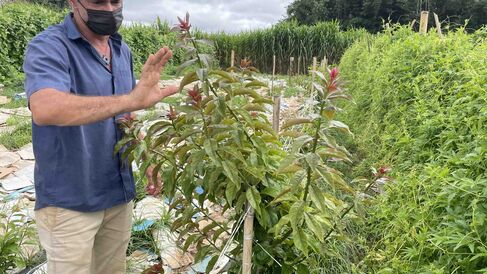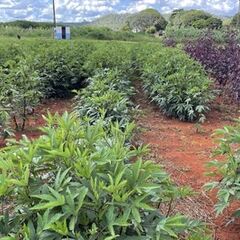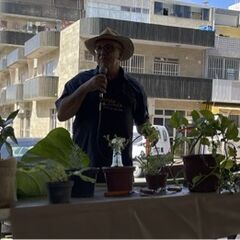
Notes from the Field: Brazilian PANCs
The fifth instalment in our project blog, where From Collection to Cultivation members share research insights, snippets, and ideas.
The image of Brazilian agriculture across the globe is polarising. For some, vast fields of technologically-advanced monoculture are the archetype of productive efficiency in the tropics – a model to feed world. For others, these images represent the ills of the Green Revolution and an omnipresent force driving deforestation of the world’s largest carbon sink. But amidst the battle over the supremacy or deficiency of Brazilian agriculture is a lesser known, but growing, facet of farming: PANCs.
PANC is a Portuguese acronym for Non-Conventional Food Crops (Plantas Alimenticiais Não Convencionais), which are part of a growing movement of scientists, farmers, and policymakers to revitalise the cultivation and consumption of neglected or underutilised crops. In Brazil, PANCs include a wide range of crops that can range from the relatively common such as batata-boroa (“baroness potato”) and capuchinha (nasturtium) to more unknown plants such as ora-pro-nóbis (Pereskia aculeata), a leafy tropical spinach. The growing popularity of PANCs for both farmers and consumers simultaneously represent more sustainable forms of agriculture, are a source of balanced nutrition, and embrace the tropical identity of traditional Brazil.
I spent two weeks in and around the capital city of Brasilia learning from agronomists, farmers, chefs, and entrepreneurs about the possibilities of PANCs from the farm to the fork. Institutionalised research on PANCs is relatively new and limited. A majority of my time was spent accompanying Nuno Madeira, an agronomist from the Brazilian Agricultural Research Corporation (Embrapa) and the leader of PANCs research there. Embrapa is a household name in agricultural research, claiming to be the ‘world’s leader in tropical agricultural research’ that oversaw the modernisation of Brazilian agribusiness.
PANCs don’t exactly fit within the history of Embrapa’s renowned research agenda. But private sector R&D has also steered clear, with close to 50% of their spending going to just two crops: corn and soybeans. When sitting down with Nuno and restauranteur-turned-farmer Paulo at a farm on the outskirts of Brasilia, they said that PANCs is about realising the ‘real’ productive potential of the tropics by embracing native tropical plants. For them, they view PANCs in contrast to other ‘traditionally temperate’ vegetable production systems, such as for tomatoes and carrots, which rely on tremendous amounts of inputs to create ‘ideal’ or ‘controlled’ conditions if they are to be productive and profitable.
Embrapa’s research project on PANCs, led by Nuno, operates at the intersection of food production, seed conservation, and seed improvement. The heart of the project is what Nuno calls a ‘living seed bank’. This bank is an in-situ PANC garden at the Embrapa Vegetables research unit, a 30-minute drive west of Brasilia. PANCs circulate here on a regularly basis— farmers contribute their varieties and new PANCs to Nuno who, in turn, shares them with other farmers. The ‘living seed bank’ operates cyclically as both a genetic base for research and a participatory research project.

While Nuno and his living seed bank work to promote the production and improve the productivity of PANCs, restauranteurs and entrepreneurs are working to promote consumption. I attended a Saturday PANCs market in the upper/middle-class neighbourhood of Asa Norte in Brasilia. At the market, leaders in the cultivation, cooking and marketing of PANCs shared their experiences, passing a microphone as they talked about the nutritional benefits, taste, cultural affinity and sustainability of PANCs cultivation and consumption. Small producers arranged their PANCs out on tables for observation and, of course, for sale. This market is a manifestation of the popularity of PANCs in Brasilia. Consumers are keen to explore the new tastes and textures of PANCs while they were also keen to learn about the nutritional benefits of plants many of their grandparents grew up eating.

Across the street from the market, a small organic supermarket-café has been in operation for just under a year. They specialise in PANCs and natural beauty products. The owner of the market gave me a quick tour and explained his business philosophy of the store. He explained that it is about ‘raising the consciousness of consumers by placing the interests of [PANCs] farmers at the centre’. Part of this process, for him, includes creating new dishes and serving meals that foreground the seasonality of PANCs. ‘When people come here to eat these new foods’, he explained, ‘they are inspired to learn more about what they are and where they come from.’
PANCs come from a range of producers. Over the course of the two weeks, I visited farms as large as 100 hectares with hundreds of employees in contrast to Nuno’s integrated PANCs production system of no more than 10 square meters, where he grows several dozen varieties. While PANCs are mostly nutritionally superior (by weight) and environmentally preferable to large-scale industrial production of ‘traditional’ vegetables, such as carrots and tomatoes, they are still less widely grown and consumed. We visited two settlements of the MST (Landless Workers’ Movement – Movimento dos Trabalhadores sem Terra), the world’s largest rural social movement, which mobilises around land occupations to provide land to some of Brazil’s most vulnerable people. Some of the most successful MST settlers have only recently started growing PANCs. And their reasons are not driven merely by business interests. ‘PANCs are harder to grow and sometimes harder to sell,’ explained one of the settlers, but his ‘[real] interest is to provide better quality and more sustainably produced products to Brazilians.’
Most of the PANCs producers in Brazil’s Federal District participate in Community-Supported Agriculture (CSA) schemes. These schemes provide them with a guaranteed income under contract while also allowing them to incorporate new crops for consumers to experience. Another MST settler explained that the CSA scheme is more important than the market to him: ‘I couldn’t even tell you how much my produce gets on the market these days… my goal is to keep my CSA customers happy because it is assured income based on diversified production.’
Combined with production support from Embrapa’s Nuno and schemes like CSAs and specialised markets, PANCs are becoming a household name in Brazil. Crops such as Vinagreira, peixinho, mangarito, araruta, mexixe-do-reino, bertália, ora-pro-nóbis, moringa, amongst dozens of others are offering new productivity possibilities for small farmers and tasty offerings for consumers in Brazil. Beyond just diversifying production and offerings on the plate, agronomic research on PANCs is also providing an exciting case for how to incorporate participatory research into mechanisms of conserving crop diversity.
You can find out more about Ryan's research at his research page here.
